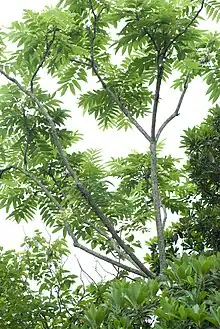Zanthoxylum ailanthoides
Zanthoxylum ailanthoides, also called ailanthus-like prickly ash,[1] (Chinese: 椿叶花椒; pinyin: chun ye hua jiao, lit. "Ailanthus-leaved pepper",[2] Chinese: 越椒; pinyin: yue-jiao; Wade–Giles: yüeh-chiao, lit. "Yue pepper",[3] 食茱萸 shi zhu yu,[4][5][6] lit. "edible shān zhū yú"; Japanese: カラスザンショウ, からすのさんしょう[5] karasu-zanshō, karasu-no-sanshō, lit. "crow prickly ash") is an Asiatic plant of the prickly-ash genus Zanthoxylum, natively occurring in forest-covered parts of southeastern China, Taiwan, Southeast Asia, and Japan from Honshu southward.[7] The piquant fruit serves as a local substitute for the ordinary red-pepper in China before the Columbian exchange.[6] In Taiwan, the young leaves are used in cuisines.[3]
| Zanthoxylum ailanthoides | |
|---|---|
 | |
| Scientific classification | |
| Kingdom: | Plantae |
| Clade: | Tracheophytes |
| Clade: | Angiosperms |
| Clade: | Eudicots |
| Clade: | Rosids |
| Order: | Sapindales |
| Family: | Rutaceae |
| Genus: | Zanthoxylum |
| Species: | Z. ailanthoides |
| Binomial name | |
| Zanthoxylum ailanthoides | |
Though some refer to the species as "Japanese prickly-ash", that name is confusing since it is sometimes applied to the sanshō which is Z. piperitum. Z. ailanthoides is not normally exploited for human consumption in Japan, except by the prehistoric people from the Jōmon period.[8] It is foraged in the wild by the Japanese macaque.[9]
A regional nickname is tara,[10] and in fact, its young shoots are often mistaken for the true tara (Aralia elata) by gatherers of wild plants.[11] The Latin name ailanthoides of the species comes from its leaves resembling those of the Ailanthus.
Like other genera of plants in the rue family, it serves as the host food plant for the larvae of several Asian swallowtail butterfly species, such as Papilio bianor, Papilio helenus, Papilio protenor, and Papilio xuthus.
References
- English Names for Korean Native Plants (PDF). Pocheon: Korea National Arboretum. 2015. p. 683. ISBN 978-89-97450-98-5. Retrieved 26 December 2016 – via Korea Forest Service.
- Zhang & Hartley 2008; the name is obviously adaptation of latin ailanthoides "ailanthus-like"
- Hu 2005, p.503
- given in zh:花椒, retrieved from (2011.12.20 11:55) version
- Nihon Daijiten Kankōkai (1973), 日本国語大辞典 (snippet), 小学館 (Shogakkan), p. 196, 「澳名に食茱萸を当てる。からすのさんしょう..カラスザンセウ」(This dictionary states 食茱萸 as Cantonese for karasu-zansho)
- Stuart & Smith 1985, p.462 gives 食菜萸 but probably mistype since this is not pronounced Wade–Giles: Shih-chu-yü
- 川原勝征; 初島住彦 (2001), 南九州・里の植物: 太陽の贈り物 (preview), 図書出版 南方新社, p. 175, ISBN 9784931376502(hamlet plants of Southern Kyushu)
- Yasushi Kosugi (小杉康) et al.『大地と森の中で: 縄文時代の古生態系』同成社, 2009, p.145
- Leca, Jeanan-Baptiste; Huffman, Michael; Vasey, Paul (2012), The Monkeys of Stormy Mountain: 60 Years of Primatological Research (google), Cambridge University Press, p. 367, ISBN 9780521761857
- 川原勝征 & 初島住彦 2001, p.175
- 川原勝征 (2005), 野草を食べる: 山菜ガイド (preview), 南方新社, ISBN 9784861240485p.64
Sources
- Zhang, Dianxiang; Hartley, Thomas G. (2008), "1. Zanthoxylum Linnaeus, Sp. Pl. 1: 270. 1753.", Flora of China, 11: 53–66 PDF
- Hu, Shiu-ying (2005), Food plants of China (preview), vol. 1, Chinese University Press, ISBN 9789629962296
- Stuart, George Arthur; Smith, Frederick Porter (1985), Chinese materia medica (snippet), vol. vegetable kingdom, Southern Materials Center, 1985